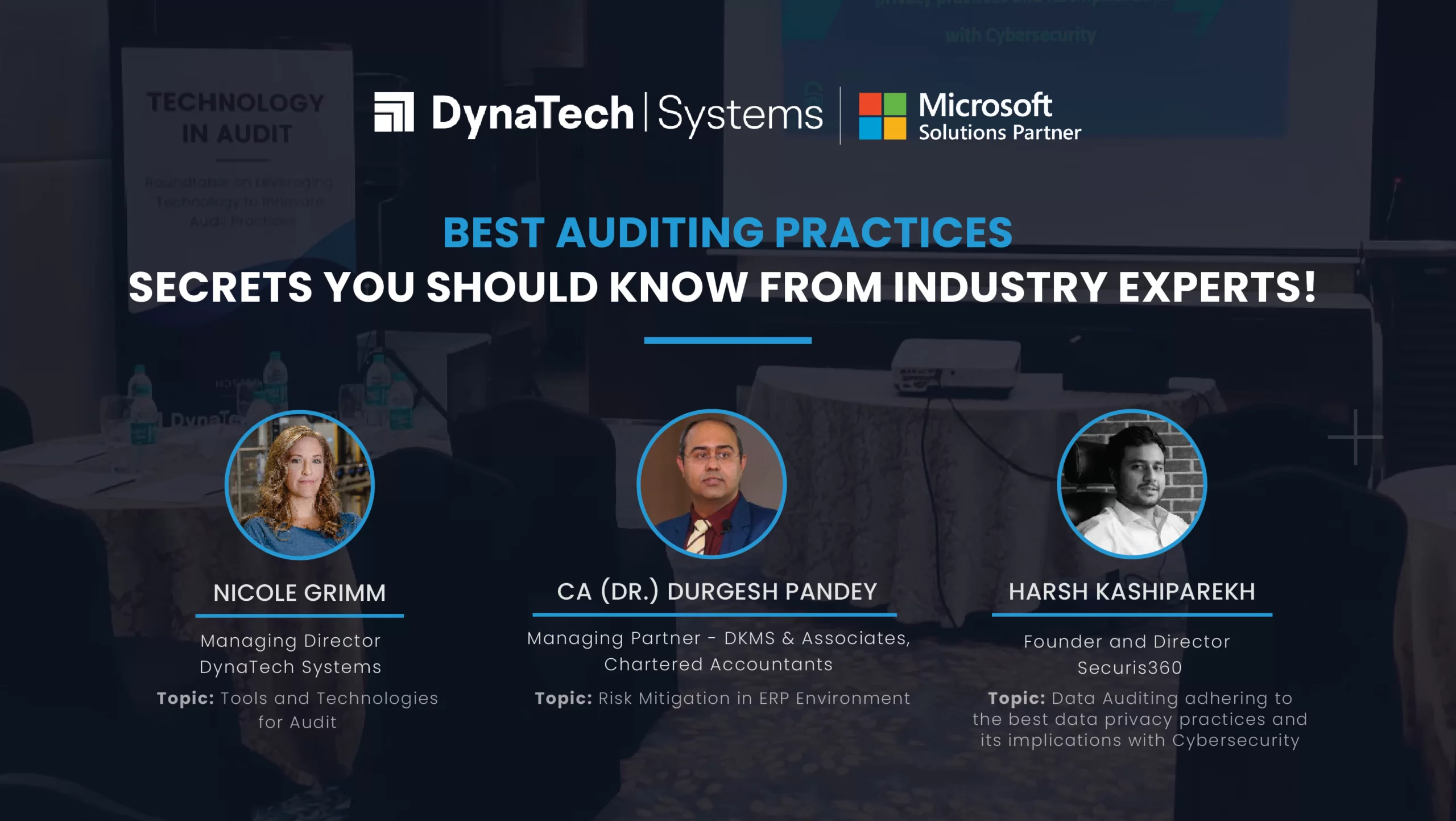In a recent roundtable discussion on auditing practices, industry leaders shared invaluable insights into the dynamic and evolving landscape of data auditing, risk mitigation in ERP environments, and the transformative role of cutting-edge technologies in shaping the future of auditing. The panel featured:
Harsh Kashiparekh, Founder & Director of Securis360
CA Durgesh Pandey from DKMS and Associates,
Nicole Grimm, Managing Director of DynaTech Systems (USA)
They offered a comprehensive overview of critical aspects influencing the future of auditing. This blog is dedicated to understanding the causes of cyber threats, why IT assessments are necessary, what tools we require, risk mitigation strategies, RPA in auditing, and much more:
Data Auditing and Cybersecurity Challenges
Data auditing plays a pivotal role in bolstering cybersecurity measures and safeguarding various information assets from potential threats. Harsh Kashiparekh began the discussion by emphasizing the critical importance of data auditing in cybersecurity. He identified various information assets susceptible to threats, including.- Personal Information
- Cloud Customer Data
- Budgets
- Intellectual Property
- Legal Resources
Top Cybersecurity Threats
Phishing emails were identified as a significant cybersecurity threat, taking the forms of Mass, Spear, and Whaling attacks. These attacks utilize various techniques, such as click-through links, malicious attachments, and web form captures. Notably, the risk is heightened when dealing with third-party service providers.
Significance of International Laws
Kashiparekh highlighted the significance of international laws and regulations governing data protection, citing examples such as the Data Protection Act in the UK, the Electronic Communications Privacy Act in the USA, and the Data Protection Bill in India.
The Need for Robust IT Assessments
A robust IT assessment is a comprehensive evaluation of an organization’s information technology infrastructure, focusing on key dimensions:
- Process Security Controls: Reviewing policies, access controls, and authentication mechanisms.
- Compliance Management: Maintain strict adherence to industry standards and legal regulations.
- Disaster Recovery and Business Continuity: Assessing backup procedures and recovery plans for prompt resumption.
- Incident Response Management: Scrutinizing incident response procedures for effective handling.
- Information Security Policies: Evaluating clarity, relevance, and enforcement of security policies.
- Cryptography and Communications Security: Assessing encryption strength and secure communication protocols.
- Human Resources Security: Reviewing employee training, awareness, and access management.
- Business Continuity Management: Examining strategies for maintaining essential functions during disruptions.
- System Acquisition, Development, and Maintenance: Identifying vulnerabilities in the life cycle of IT assets.
- Supplier Relationships: Evaluating security measures in third-party partnerships.
- Incident Management: Assessing the organization’s ability to respond and learn from incidents.
Data disposal checks were emphasized as a crucial aspect of information security, ensuring that sensitive data is appropriately disposed of to prevent unauthorized access or misuse. Also, discussions revolved around SOC 2 audits, focusing on Security, Confidentiality, Availability, Processing Integrity, and Privacy aspects.
Risk Mitigation in ERP Environments
CA Durgesh Pandey shifted the focus to risk mitigation in ERP environments, diving into the subset of risk management involving identification, analysis, evaluation, and control. He highlighted the importance of fraud prevention through the formalization of working systems capable of identifying and responding to fraud indicators promptly.
Pandey introduced the concept of the four lines of defense in an anti-fraud system:
- Entity Level Controls: Code of conduct, business ethics, policies, and procedures.
- Process Level Controls: Internal control and corporate risk management.
- Risk Based Internal Audit: Focused on identifying and mitigating risks.
- Fraud Investigation: The final line of defense in the event of suspected fraud.
Most Common Challenges in Fraud Prevention
- Management Override of Controls: The ability of management to override established controls undermines the effectiveness of fraud prevention efforts.
- Perception of Irrelevance and Mundanity: Employees may perceive fraud prevention measures as mundane or irrelevant to their daily tasks.
- Lack of Segregation of Duties: Inadequate separation of duties can lead to a situation where a single individual has control over multiple aspects of a process.
- Conflict in Delegation of Authority: Conflicts in authority delegation may arise, leading to confusion and potential misuse of powers.
- Lack of Timely Reporting: Delays in reporting suspicious activities or incidents of fraud can impede swift intervention.
- Ineffective Documentation: Poorly documented processes and controls hinder the ability to trace and prevent fraudulent activities.
- Ineffective Review Process: Reviews of fraud prevention measures may lack thoroughness or occur infrequently.
- Repetitive and Non-Effective Measures: Relying on outdated or ineffective fraud prevention measures.
What is CCM?
Continuous Control Monitoring is a dynamic process that employs rule-based, real-time analysis to monitor and evaluate an organization’s controls consistently. It involves the ongoing scrutiny of business processes, transactions, and data to identify and rectify anomalies promptly, ensuring compliance and reducing the risk of fraud.
How is it Different?
Unlike traditional periodic control assessments, CCM operates in real-time, providing proactive analysis and verification of the entire population of transactions. This approach enables immediate detection of breaches, transparency in remediation, and collaborative, timely responses to potential risks. CCM is particularly adept at addressing IT concerns and enhancing overall control effectiveness in today’s rapidly evolving business landscape.
Tools and Technologies for Audit
Nicole Grimm delved into the role of AI technology in audit practices, drawing a comparison between traditional and modern approaches. Comparing traditional manual methods to modern automated practices reveals a paradigm shift. The manual, limited data handling approaches are now replaced by big data analysis, enabling auditors to process vast amounts of information quickly.
Benefits of AI in Auditing
Enhanced accuracy ensures reliable financial data while increased speed and efficiency expedite the audit process. Improved risk identification, a crucial aspect of auditing, becomes more precise through AI’s advanced algorithms and pattern recognition.
Optimizing Auditing Processes With RPA
Grimm elucidated on optimizing auditing processes with Robotic Process Automation (RPA). Automating repetitive tasks, data extraction, and compliance checks, RPA optimizes auditing processes, leading to efficiency gains and cost reductions. The scalability and flexibility of RPA enable auditors to adapt to dynamic business environments seamlessly.
Enhancing Accuracy with Reconciliation Tools
The discussion continued with a focus on enhancing accuracy through reconciliation tools. These tools act as safeguards, identifying discrepancies, errors, or irregularities in financial records. Grimm also highlighted the benefits of an ERP system.
Streamlining data extraction with Optical Character Recognition (OCR)
Streamlining data extraction with Optical Character Recognition (OCR) is a game-changer in the auditing realm. OCR scanners efficiently convert physical documents into digital formats, extracting essential text and data. This not only accelerates the digitization process but also enhances accuracy, ensuring vital information from invoices, receipts, financial statements, and contracts is readily available for analysis and reporting.
Conclusion
The roundtable provided a comprehensive view of the multifaceted world of auditing, covering data security, risk mitigation, and the integration of advanced technologies. As industries continue to evolve, embracing these insights is crucial for organizations aiming to stay ahead in an ever-changing business landscape. The adoption of modern auditing practices and technologies not only enhances security but also ensures efficiency, accuracy, and compliance, paving the way for a resilient and future-ready business environment.
Ready to Transform Your Auditing Practices? Embrace the Future with Enhanced Security and Efficiency. Connect with our experts today!




























